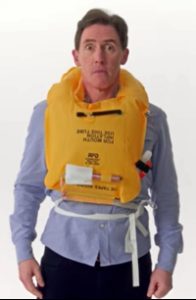Learning to present better by hopping on an airplane
Do you ever pay attention to the safety tutorials on an airplane? I’m guessing no. You’ve seen them numerous times before and they bore you to tears.
And yet, on a recent British Airways flight I watched the entire video. What made this video so exceptional? And what could it teach you about better presenting your research or project?
Let me first show you just what this safety tutorial and your research or project have in common:
- They are both crucially important. If the airplane were to crash, those instructions could save your life. Your research or project? If we take your word for it, the future of humankind depends on it.
- But close to nobody listens. Only few people are truly interested in that tutorial or your presentation.
- Tell them that what you are saying is important, and your audience will still have trouble paying attention. Because what they are listening to is boring.
These tutorials or presentations serve little purpose if no-one is listening. And that is why several airlines decided to take a different approach. Dropping the regulations was not an option, as they are required by law to communicate them. But there had to be a way to grab passengers’ attention.
What did British Airways do?
They made a brief video of a casting session in which a producer is looking for actors to star in a new safety tutorial video. Several well-known British actors do their very best to make a good impression. Because each actor is asked to recite part of the instructions, we eventually hear the full safety information, brought to us by those different actors.
And what’s the result? Passengers watch the entire video and remember its message. (Someone even thought to write a blog post on it! ?)
You too could be using similar tricks to capture your audience’s attention.
Rule number one? Surprise your audience!
Do the unexpected. The more you think outside the box, the more engaged they will be. Why not incorporate one or more of these elements in your next presentation:
1. Tell a story
Don’t just list a series of facts, but really connect the dots. What is the biggest challenge of your research or project? How could you overcome it? Talk about your obstacles and sprinkle in some emotion.
In the safety video we see one of the actors pull the cord of his yellow life vest. In a split second the vest fully inflates. Pretty cool. Definitely something I’ve never seen on an airplane. An image that will stick with you, because something happens. What could you show or demonstrate during your presentation?
3. Add elements that will trigger your audience
The safety video concludes with Mister Bean wanting to donate some money to the charity. The actor immediately puts a smile on our face. Try to link your topic to a celebrity or an important event. Are you presenting during the World Cup? Why not incorporate a joke or story about football.
‘Sure, but my presentation is on a very serious topic.’
‘I can’t possibly joke around on stage,’ you may say. Well, what about safety instructions? Are those not serious enough for you?
The more important your message, the more effort you’ll need to put into drawing your audience’s attention. But the better you reel them in, the better they will understand and remember your message. So make sure your message is clear.
On your next flight, go ahead and watch that safety video. But before you recline your seat to enjoy the latest blockbuster, take a minute to consider how you could make your presentation just as exciting as that movie you will be watching.
Wishing you a pleasant… and safe trip!
(Are you still looking for an interesting book for your next holidays? Our suggestion: ‘The Floor is Yours. Because life is too short for bad presentations‘)
Photo 1: Omar Prestwich for Unsplash
Photo 2: British Airways
PS: British Airways is not the only one that has presented his safety instructions in a fun way.
Air New Zealand: The most epic safety video ever made
Brussels Airlines: RED for take-off, met de Rode Duivels

